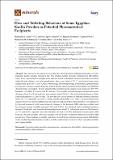Por favor, use este identificador para citar o enlazar a este item:
http://hdl.handle.net/10261/214034COMPARTIR / EXPORTAR:
 SHARE SHARE
 CORE
BASE CORE
BASE
|
|
| Visualizar otros formatos: MARC | Dublin Core | RDF | ORE | MODS | METS | DIDL | DATACITE | |

| Título: | Flow and Tableting Behaviors of Some Egyptian Kaolin Powders as Potential Pharmaceutical Excipients |
Autor: | Awad, Mahmoud E.; López Galindo, Alberto CSIC ORCID; Medarevic, Djordje; Đuriš, Jelena; El-Rahmany, Mahmoud M.; Ibric, Svetlana; Viseras, César | Palabras clave: | Egyptian kaolin Powder Microstructure Micrometrics Flowability Tableting properties Manufacturability Table hardness |
Fecha de publicación: | 26-dic-2019 | Editor: | Multidisciplinary Digital Publishing Institute | Citación: | Minerals 10(1): 23 (2020) | Resumen: | The present work aimed at assessing the pharmaceutical tableting properties of some Egyptian kaolin samples belong to the Abu Zenima kaolin deposits (estimated at 120 million tons). Four representative samples were selected based on kaolinite richness and their structural order-disorder degree, and after purification, they were dried at 70 °C and heated from room temperature up to 400 °C (10 °C/min). Mineralogy, micromorphology, microtexture, granulometry, porosimetry, moisture content, bulk and tapped density, direct and indirect flowability, and tableting characteristics are studied. Results indicated that purified kaolin samples were made up of 95–99% kaolinite, <3% illite, 1% quartz and 1% anatase. The powder showed mesoporous character (pore diameters from 2 to 38 nm and total pore volume from 0.064 to 0.136 cm3/g) with dominance of fine nanosized particles (<1 μm–10 nm). The powder flow characteristics of both the ordered (Hinckley Index HI > 0.7, crystallite size D001 > 30 nm) and disordered (HI < 0.7, D001 < 30 nm) kaolinite-rich samples have been improved (Hausner ratio between 1.24 and 1.09) as their densities were influenced by thermal treatment (with some observed changes in the kaolinite XRD reflection profiles) and by moisture content (variable between 2.98% and 5.82%). The obtained tablets exhibited hardness between 33 and 44 N only from the dehydrated powders at 400 °C, with elastic recovery (ER) between 21.74% and 25.61%, ejection stress (ES) between 7.85 and 11.45 MPa and tensile fracture stress (TFS) between 1.85 and 2.32 MPa, which are strongly correlated with crystallinity (HI) and flowability (HR) parameters. These findings on quality indicators showed the promising pharmaceutical tabletability of the studied Egyptian kaolin powders and the optimization factors for their manufacturability and compactability | Versión del editor: | https://doi.org/10.3390/min10010023 | URI: | http://hdl.handle.net/10261/214034 | DOI: | 10.3390/min10010023 | E-ISSN: | 2075-163X |
| Aparece en las colecciones: | (IACT) Artículos |
Ficheros en este ítem:
| Fichero | Descripción | Tamaño | Formato | |
|---|---|---|---|---|
| CViseras_Minerals10_23.pdf | Artículo principal | 5,68 MB | Adobe PDF |  Visualizar/Abrir |
CORE Recommender
SCOPUSTM
Citations
17
checked on 22-abr-2024
WEB OF SCIENCETM
Citations
15
checked on 27-feb-2024
Page view(s)
116
checked on 24-abr-2024
Download(s)
80
checked on 24-abr-2024
Google ScholarTM
Check
Altmetric
Altmetric
Este item está licenciado bajo una Licencia Creative Commons

